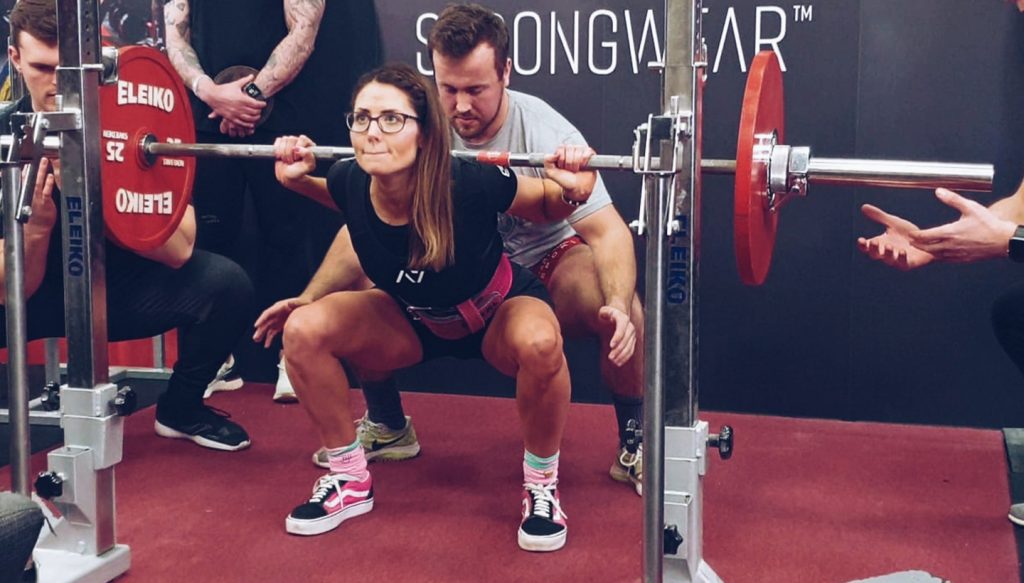Discover your inner strength…..
I had just been to the gym for a fun weight training session with my coach Luke. Although I didn’t know it for sure, the gyms were getting quieter and I had a feeling this may be the last session I was going to have there for a while. So when I got home, I started to look to see what equipment I could fit into my spare room. That night, Lockdown was announced and I hit that ‘buy’ button without any hesitation.
3 months later and I am typing this up after getting up early to do a workout at home with the weights I was able to purchase before every company ran out and/or started charging £50 for a set of 2kg dumbbells.
If you had told me a few years ago that I would be so upset at the thought of not being able to go to the gym that I created my own mini home gym, I would have laughed at you and called you crazy!
Because until 2015, fitness to me meant dragging myself to the gym after failing to come up with an excuse good enough not to go, and doing 30minutes on the cross trainer before getting bored and leaving.
Aerobic exercise was once seen as the holy grail of fitness, and I also thought it was the only way to get the body I wanted. But I woke up (and the world is slowly waking up too), to the fact that strength training is another very important kind of exercise. And more and more women are picking up barbells and dumbbells, increasing their strength and power, and empowering others because of it.
I was tired of doing exercise that I didn’t enjoy, and wasn’t getting me the results I wanted. I was losing weight, but I wasn’t gaining any shape, so I took the plunge and booked a personal training session with Exclusive PT, who specialised in strength training for all levels of clients. And guess what…I’ve never looked back!

Our muscle strength peaks in our 30s and then starts to slowly decline. Eventually, our strength drops so low that we are unable to do simple things we take for granted like standing up out of chairs and climbing the stairs. So it’s really important that we start to think about this when it comes to our health and fitness. And it’s not just the elderly that can benefit from strength training. There are so many physical and mental health boosts that go far beyond just being strong. I would love it if everyone did exercise to benefit their overall health rather than just looking at it as something they need to endure to burn off a pizza they ate the night before. Because there are so many more benefits to be found!
I recently read an article that stated….
“It’s an urgent message that needs to get through,” says Stuart Gray, who studies metabolic diseases at the University of Glasgow, UK. “People need to know that strength training is important at any age”.
Weight training still seems to be something that a lot of people avoid. I think it may be because they see it just as something people do when they want to ‘bulk up’ and build lots of muscle. Strength training is often far down people’s priority lists, particularly if their main aim is weight-loss, or if the weight section of a gym simply seems a bit intimidating. However, what I have learnt over the years is those that often look the ‘scariest’ in the gym, are often the friendliest, kindest and most helpful people you will ever meet. I have also learnt how hard it is to build muscle…it’s not something that will happen overnight, or even over a few months. Although saying this, I found it was the quickest way to change my body shape and start getting the results I was after. It’ll tighten and tone all over your body, and shape your curves exactly how you want them.

If you’re simply looking to improve overall shape of your body and improve your body composition, then lifting weights is a hugely important component of a well-rounded fitness routine. You could slog away on the cross trainer for hours trying to burn fat. But the secret to a tighter body isn’t in burning off every ounce of fat with cardio, it’s in creating a solid, muscular base. And if you have the right personal trainer with you, they can help you find a routine that works for you and your goals…..Want a perkier bum? Do squats and deadlifts. Want more defined arms and back? Do some shoulder presses and pull-ups.
About 50% of the UK population get enough aerobic exercise and only 25% get enough strength building exercise, despite the World Health Organisation recommending at least two strengthening activities per week. The benefits of aerobic exercises are shouted out from the rooftops by so many, so a lot of people focus only on seeing this as worthwhile exercise. If it doesn’t get you into a hot and sweaty mess at the end, they think it’s not worth doing.
Many people might only see strength training as picking up heavy weights in the gym and then dropping them so loudly that everyone knows exactly how strong you are 😉. But strength training is so much more than this. Any form of resistance training will give you the same benefits. So anything that causes your muscles to contract against an external force… your own bodyweight or bands counts.
Although a weight-training workout doesn’t typically use as many calories as a cardio workout, it has other important benefits. As you put your muscles under pressure and cause tiny tears in the tissue, your body uses a lot of energy to repair them, meaning the energy demand from your strength training session can last a while post workout. So although many people don’t see weight training as a way to lose weight, it can definitely help if you want to decrease body fat, a factor associated with lower cholesterol, lower blood pressure and an improved insulin sensitivity and glucose control, all of which contribute to a decreased risk of type 2 diabetes and cardiovascular disease. So getting stronger can help reduce your risk of a heart attack. The best evidence comes from studies of the exercise habits of large numbers of people. One showed that lifting weights for less than an hour a week reduces the risk of heart attack and stroke by up to 70%, independent of any aerobic training.
Another surprising fact and benefit of strength training is how it uses up calories even after the workout is over by increasing your basal metabolic rate (which is the amount of energy your body consumes when at rest). Weight training is more effective than cardio at building muscle, and muscle uses more calories at rest than some other tissues, including fat.
One study measured participants’ resting metabolisms during 24 weeks of weight training.
In men, weight training led to a 9% increase in resting metabolism (around 140 calories a day). The effects in women were smaller, but still had an increase of almost 4% (around 50 calories a day). After you finish an aerobic exercise, your body gradually returns to its normal level of calorie usage. However, with strength training, as the size of your muscles increases, your body uses even more of your calorie reserves every day to meet your ongoing energy needs. And as we all know…every little counts!

I believe a lot of people know how strength training builds your muscle mass, but I’m not so sure many people understand how it can strengthen your bones. Before I started to actively learn about it all, I’m not sure I did either to be honest! Cells in our body are constantly being broken down (by osteoclasts) and being built back up again (by osteoblasts). Oestrogen normally stimulates the bone building cells, so as a result, women tend to lose bone mass and strength for several years following the menopause. Activities that put stress on bones trigger the activity of your bone-forming cells into action. The result is stronger, denser bones. This significantly lowers your risk of osteoporosis, which Worldwide, causes more than 8.9 million fractures annually, resulting in an osteoporosis fracture every 3 seconds.
Age related muscle loss happens to everyone, and as I’m nearing 40 it’s something I take very seriously. I want to do everything I can to stay fit and active for as long as possible. I’m not saying I’m old, but I am definitely over the age of my peak muscle mass by at least 10 years so I now want to preserve as much as I can for as long as I can. Physically inactive people can lose as much as 3% to 5% of their muscle mass each decade after age 30. And even if you are active, you’ll still have some muscle loss.This loss typically happens faster around age 75. But it may also speed up as early as 65 or as late as 80. It’s a factor in frailty and the likelihood of falls and fractures in older adults.
The stronger your muscles are as you age, the less likely you are to have a wobble or a fall, thus preventing the debilitating effects from these. And it improves your ability to live independently for longer, by making sure you have the power to cope with everyday activities such as getting to the bathroom.

Hopefully it’s clear to see why I believe strength training is important. You can use resistance training to reach all types of health and fitness goals, and this includes aesthetics and training for strength based competitions. But you can just use it to be fit, healthy, and confident. Lifting weights and building strength not only helps improve body composition, and overall health but it also helps build confidence, and improves self-esteem and mental health.
I have certainly found many more benefits to strength training than I was initially looking for. I went in to it looking for a better looking body. But what I came out with is confidence, empowerment, strength, friends, a career that I’m passionate about, a new outtake on life, energy and mental strength. And that’s only the benefits I can physically feel! I am confident that I’m giving my body the tools it needs to support me for a healthy long life full of opportunity.

If you want to start weight training but are not sure where to start, Exclusive PT have all the expert knowledge you need so don’t be afraid to reach out and speak to us x
